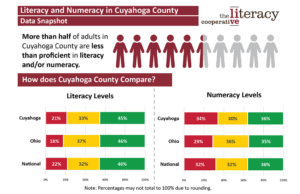Improved literacy and numeracy skills will create a larger pool of qualified workers: Laureen Atkins
Laureen Atkins is the Vice President of Strategic Initiatives at The Literacy Cooperative.
Recently, the Fund for Our Economic Future presented survey data detailing how employers are attracting new employees or keeping current ones. The data revealed that talent shortages are widespread, with 93.6% of employers facing shortages and saying that the pool of qualified applicants does not meet their needs. When further asked about the biggest workforce-related challenges, 85% cited recruitment, with more than half again mentioning the lack of qualified candidates.
With that many unqualified candidates, what are we doing to develop their skills to qualify for these opportunities?
Low literacy and numeracy skills, or the ability to work with numbers, are contributing factors to the number of workers who are underqualified. Advancing these skills is an opportunity to create more qualified candidates seeking new employment and who are interested in advancing in their careers.
As a community, we need to provide long-term investments for the adults with the lowest literacy and numeracy levels to give them the time and opportunity to have economic mobility. Employers have the opportunity to make short-term investments in literacy and numeracy upskilling, which can result in immediate career placement and advancement.
According to the Program for the International Assessment of Adult Competencies (PIAAC), a cyclical, large-scale international study, the current state of the workforce indicates: 
- 54% of adults in Cuyahoga County are not at a proficient level of literacy.
- 64% are not at a proficient level of numeracy.
- The national average is consistent with Cuyahoga County’s.
Of the adults in the category of “not proficient,” 21% are at the lowest levels of literacy and 34% are at the lowest levels of numeracy. For these adults, it is difficult for them to read simple text, complete simple forms, or add and subtract. But what about the other adults included in these numbers who are not at the lowest levels? They could benefit from literacy and numeracy upskilling, and within a short period of time, be able to upgrade their skills to be job-ready. In fact, many semi-skilled blue-collar and white-collar jobs do not require skills beyond this “near” proficiency category.
Employers report offering training to current employees and hiring from within. PIAAC data show that the majority of workers not proficient in literacy and numeracy are employed. They have most likely adapted to their current duties but may face difficulties taking on new responsibilities. Therefore, these adults may lack confidence to apply for positions, especially if they know there is a pre-entry assessment or long period of on-the-job training. Offering training that integrates literacy and numeracy instruction provides an inclusive solution to those who need refreshers and are uncomfortable disclosing this information.
Together as a community, we can advocate to pool government and employer funding for adult education, workforce development and postsecondary education to integrate literacy and numeracy with occupational skills development. We can recommend to employers to bring literacy and numeracy advancement onsite, either through workplace literacy programs or incorporating literacy and numeracy refreshers with on-the-job training. We can advocate for government funding to reimburse employers that do not have sufficient resources but need these remedies to advance workers.
In addressing the labor shortage, we want to make sure the solutions are equitable and inclusive. Let’s simply include literacy and numeracy in any type of training. Let’s create a learning environment where unqualified candidates can learn what is needed to become qualified.
To learn more about integrating literacy and numeracy instruction into job training, click here.
